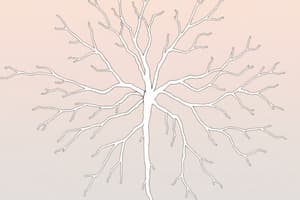Podcast
Questions and Answers
What are the two main systems that control and coordinate functions of all body systems?
What are the two main systems that control and coordinate functions of all body systems?
Nervous and Endocrine systems
What division of the nervous system is responsible for sensory functions?
What division of the nervous system is responsible for sensory functions?
- Sensory Division (correct)
- Central Nervous System
- Motor Division
- Peripheral Nervous System
The nervous system performs long-term management functions.
The nervous system performs long-term management functions.
False (B)
What is the role of the endocrine system?
What is the role of the endocrine system?
Match the following components of the brain with their functions:
Match the following components of the brain with their functions:
The ________ system consists of the generation of nerves and impulses.
The ________ system consists of the generation of nerves and impulses.
Which of the following is NOT a function of the nervous system?
Which of the following is NOT a function of the nervous system?
What does the Central Nervous System consist of?
What does the Central Nervous System consist of?
Study Notes
Introduction to the Nervous System
- The nervous system generates nerves and impulses, facilitating communication within the body.
- The endocrine system produces hormones, influencing target organs to elicit various physiological changes.
- Both systems work together in a coordinated manner referred to as the Neuroendocrine system.
Functional Organization of the Nervous System
- The sensory division processes sensory information from the environment.
- The motor division coordinates muscle responses based on sensory input.
Anatomical Organization
- The nervous system is divided into two main parts: the Central Nervous System (CNS) and the Peripheral Nervous System (PNS).
- The CNS comprises the brain and spinal cord, while the PNS includes all peripheral nerves.
Nervous Tissue
- Neurons are the fundamental units of the nervous system, responsible for transmitting electrical impulses.
- Nervous tissue can be structurally categorized into grey matter (neuron cell bodies) and white matter (myelinated axons).
Brain Structure
- The brain features various structures including fissures, gyri, lobes, hemispheres, and subcortical nuclei.
- Key brain regions include:
- Cerebral Hemisphere: Divided into left and right, each with distinct functions.
- Thalamus: Acts as a relay station for sensory and motor signals.
- Hypothalamus: Regulates homeostasis, including temperature and hunger.
Brainstem Functions
- The brainstem comprises the medulla, pons, and midbrain, playing crucial roles in autonomic functions.
- Medulla: Controls involuntary actions such as breathing and heart rate.
- Pons: Connects different parts of the brain and regulates sleep.
- Midbrain: Involved in functions such as vision and hearing.
Cerebellum
- The cerebellum is essential for coordination, balance, and fine motor control.
- It integrates sensory input to monitor and adjust movements.
Importance of Nervous and Endocrine Systems
- The nervous system is vital for short-term crisis management, enabling immediate actions like swallowing.
- The endocrine system regulates long-term metabolic processes, such as digestion and growth through hormone secretion.
Summary of System Interactions
- The two systems—nervous and endocrine—must function together to maintain homeostasis and respond effectively to internal and external stimuli.
Studying That Suits You
Use AI to generate personalized quizzes and flashcards to suit your learning preferences.
Related Documents
Description
Explore the intricate organization of the nervous system in this first lesson of Neurosciences for Occupational Therapy. Dr. Joselito Diaz guides you through essential concepts and applications relevant to occupational therapy. Perfect for students and practitioners looking to enhance their understanding.




